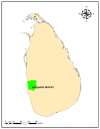Prevalence of Ectoparasitic Infections and Other Dermatological Infections and Their Associated Factors among School Children in Gampaha District, Sri Lanka
- PMID: 31019612
- PMCID: PMC6452534
- DOI: 10.1155/2019/5827124
Prevalence of Ectoparasitic Infections and Other Dermatological Infections and Their Associated Factors among School Children in Gampaha District, Sri Lanka
Abstract
Skin disorders are one of the commonest conditions among school children in developing countries. There are only a few published studies available from Sri Lanka on the prevalence of skin disorders. A community-based cross-sectional study was carried out among five government-run schools randomly selected from the district of Gampaha, Sri Lanka, during 2016-2017. A total of 41 students between 5 and 16 years of age were randomly selected from each school. Sociodemographic profile and hygienic behaviors of selected students were assessed using a pretested interviewer-administered questionnaire. Students were examined by a medical officer for the presence of different skin disorders. The chi-squared test of association and binary logistic regression were used for the identification of the significance of socioeconomic factors and hygienic practices among the study participants. A total of 205 school children participated in the study. The commonest skin disorder was pediculosis (42.0%; n=86), followed by dandruff (8.3%; n=17), fungal infections (6.8%; n=14), and scabies (1.5%; n=3). Almost one-fourth of the study participants (22.9%; n=30/131) had more than one disorder, majored by Pediculus captis infestation with dandruff. Over one-third (36.1%; n=74) were free of any skin disorders. The prevalence of skin disorders was significantly high among females (87.3%; n=110), compared to males (26.6%; n=21). Presence of long hair, higher family size, and limited number of rooms in the house were risk factors associated with the prevalence of skin disorders. The commonest skin disorder was pediculosis, while scabies and fungal infections were scarce among school children in the district of Gampaha, Sri Lanka. Implementation of health education and monitoring programs at the school level for maintaining the dermal health status of school children is recommended.
Figures
Similar articles
-
Level of Awareness of Dengue Disease among School Children in Gampaha District, Sri Lanka, and Effect of School-Based Health Education Programmes on Improving Knowledge and Practices.Biomed Res Int. 2019 Jun 19;2019:3092073. doi: 10.1155/2019/3092073. eCollection 2019. Biomed Res Int. 2019. PMID: 31321232 Free PMC article.
-
Prevalence and correlates of burnout among collegiate cycle students in Sri Lanka: a school-based cross-sectional study.Child Adolesc Psychiatry Ment Health. 2018 Jun 1;12:26. doi: 10.1186/s13034-018-0238-z. eCollection 2018. Child Adolesc Psychiatry Ment Health. 2018. PMID: 29881452 Free PMC article.
-
[Pediculosis prevalence and associated risk factors in a nursery school, Bogotá, Colombia].Biomedica. 2008 Jun;28(2):245-51. Biomedica. 2008. PMID: 18719727 Spanish.
-
A health promotion intervention to address youth violence among students in a technical college in Sri Lanka guided by the participatory action research approach: a study protocol.Res Involv Engagem. 2022 Oct 22;8(1):57. doi: 10.1186/s40900-022-00393-3. Res Involv Engagem. 2022. PMID: 36273215 Free PMC article. Review.
-
Pediculosis capitis among school-age students worldwide as an emerging public health concern: a systematic review and meta-analysis of past five decades.Parasitol Res. 2020 Oct;119(10):3125-3143. doi: 10.1007/s00436-020-06847-5. Epub 2020 Aug 15. Parasitol Res. 2020. PMID: 32803332
Cited by
-
Awareness and knowledge of scabies and ringworm among parents of school-age children in Calabar, Cross River State, Nigeria: Implications for prevention of superficial skin infestations.Ann Afr Med. 2024 Jan-Mar;23(1):62-69. doi: 10.4103/aam.aam_82_23. Ann Afr Med. 2024. PMID: 38358173 Free PMC article.
-
Outbreak of Cutaneous Leishmaniasis among military personnel in French Guiana, 2020: Clinical, phylogenetic, individual and environmental aspects.PLoS Negl Trop Dis. 2021 Nov 19;15(11):e0009938. doi: 10.1371/journal.pntd.0009938. eCollection 2021 Nov. PLoS Negl Trop Dis. 2021. PMID: 34797836 Free PMC article.
-
Pediculosis capitis in Abidjan, Côte d'Ivoire: Epidemiological profile and associated risk factors.Parasite Epidemiol Control. 2020 Jun 20;11:e00159. doi: 10.1016/j.parepi.2020.e00159. eCollection 2020 Nov. Parasite Epidemiol Control. 2020. PMID: 32715112 Free PMC article.
-
Prevalence and determinants of scabies: A global systematic review and meta-analysis.Trop Med Int Health. 2024 Dec;29(12):1006-1017. doi: 10.1111/tmi.14058. Epub 2024 Nov 22. Trop Med Int Health. 2024. PMID: 39575757 Free PMC article.
-
Risk factors associated with scabies infestation among primary schoolchildren in a low socio-economic area in southeast of Iran.BMC Pediatr. 2021 May 25;21(1):249. doi: 10.1186/s12887-021-02721-0. BMC Pediatr. 2021. PMID: 34034686 Free PMC article.
References
-
- World Health Organization. Epidemiology and Management of Common Skin Diseases in Children in Developing Countries. Geneva, Switzerland: WHO; 2005.
-
- Nair B. K., Joseph A., Kandamuthan M. Epidemic scabies. Indian Journal of Medical Research. 1977;65:513–518. - PubMed
LinkOut - more resources
Full Text Sources




